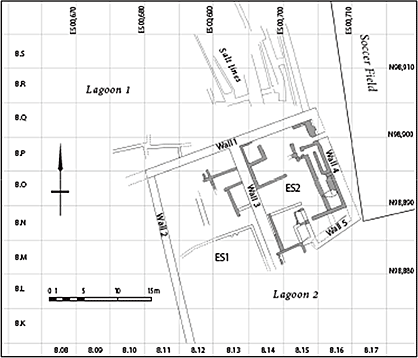Posted by Simon Davis
Two weeks down, five to go and we haven’t even started digging yet!
Well actually three weeks down now as we spent the last week under curfew and not able to work.
We are at the end of our second week of work at Standing Wall Island (SWI) and what appeared at first to be a discreet jumble of stone and mudbrick walls is fast transforming itself into an archaeological site (amazing what a bit of site grid can do!). Our aim, to uncover the previous recording work carried out by AERA back in 2004 to try and work out how SWI fits into the rest of the plateau complex that sprawls out to the north.
The site literally is an island, a raised bank of sand that emerges out of two muddy lagoons flanking it to the north and south. These lagoons until a few years ago contained standing water and the ‘Island’ is only recently available for excavation again. It’s not only physically separated from the rest of the site but the standing walls lie on a slightly different alignment to the rest of the settlement complex. A missing piece of the jigsaw then? Well maybe and tempting to suggest, but it’s certainly worthy of a second look.

Fig 1: Plan of Standing Wall Island as seen in 2004
I’ve arrived a week later than the rest of the team but the first couple of weeks have been a concerted attempt by all to re-expose the site, clean it up and prepare for excavation. Unlike the Valley Temple, no such lack of backfilling here and there are literally hundreds of tons of sand to remove. The archaeology too has degraded little since its exposure in 2004 and there are walls and structures spread all over the site (sorry Amelia!). It always impresses me in these situations how such a large and mixed team of people, directed by a bunch of almost total strangers can get along and achieve so much in a short time. The site is still being affected by the water table though and much of the south part of the area has groundwater just below the surface.
We’ve still a bit more site preparation to do next week, odd places to remove sand from including a cut in the shape of a grave! We need to clean-up the walls and find the end of one that disappears some 50m out of the south of the area, but essentially we are about to start the excavation and define our digging/research strategy. It’s my first time in Egypt and working on the plateau has been quite the introduction, the Pyramids (which I still can’t believe are so close) in the early morning haze, are frankly awesome, I just need to find the time to visit them.

Fig 2: The area under excavation from the southern lagoon, looking north. Photo by Simon Davis

Fig 3: Removal of the rubbish and sand deposits covering the walls. Photo by Simon Davis
We are now back at work (7 Feb. 2011)
